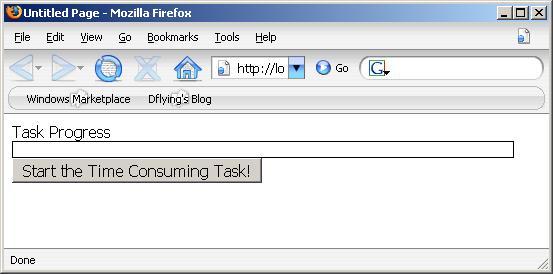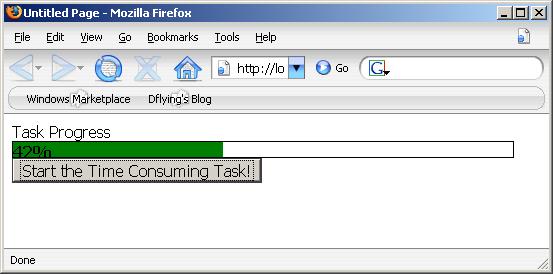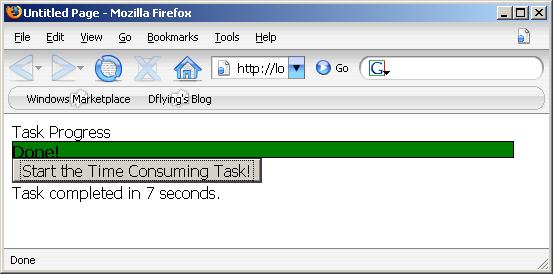当后台在进行某些长时间的操作时,如果能在页面上提供一个显示真实进度的进度条,而不是让用户不知情的等待或是从前的那些简单的估计,将是一个非常难得的出彩之处。现在使用ASP.NET Atlas完全有可能做到这些。这篇文章将讨论如何完成这一功能并介绍一些有关Atlas客户端控件开发的基本概念。您同时可以。
实现网页上的进度条想法其实很简单:编写一个客户端的Atlas控件,每隔一段时间请求一次服务器,并使用返回的当前进度数据更新进度条的显示。在这个示例中,将有四个部分的代码组成:
- 一个需要较长时间才能完成的Web Service
- 一个用来查询上述Web Service进度的Web Service
- 客户端Atlas进度条(ProgressBar)控件,负责维护客户端逻辑并输出可视化UI。这也是本示例中最重要的一个组件,在将来可被重用于其他页面或程序的开发
- 包含上述Web Service以及控件的ASP.NET测试页面
下面我们一步一步地来实现以上四个步骤:
需要较长时间完成的Web Service
在实际的程序中,一个需要较长时间完成的Web Service可能有如下声明:
 [WebMethod] 2
[WebMethod] 2  public void TimeConsumingTask() 3
public void TimeConsumingTask() 3 

 { 4
{ 4 ConnectToDataBase();5
ConnectToDataBase();5 GetSomeValueFromDataBase();6
GetSomeValueFromDataBase();6 CopySomeFilesFromDisk();7
CopySomeFilesFromDisk();7 GetARemoteFile();8
GetARemoteFile();8 }
} 这样我们就可以插入一些辅助方法来确定当前进度完成情况,setProgress(int)用来设定当前的进度完成百分比:
 [WebMethod] 2
[WebMethod] 2  public void TimeConsumingTask() 3
public void TimeConsumingTask() 3 

 { 4
{ 4 setProgress(0); 5
setProgress(0); 5 ConnectToDataBase(); 6
ConnectToDataBase(); 6 setProgress(10); 7
setProgress(10); 7 GetSomeValueFromDataBase(); 8
GetSomeValueFromDataBase(); 8 setProgress(40); 9
setProgress(40); 9 CopySomeFilesFromDisk();10
CopySomeFilesFromDisk();10 setProgress(50);11
setProgress(50);11 GetARemoteFile();12
GetARemoteFile();12 setProgress(100);13
setProgress(100);13 }
} 在本示例中,我们仅仅使用Cache来储存进度完成信息并利用Thread.Sleep()方法模拟操作的延迟:
 [WebMethod] 2
[WebMethod] 2  public int StartTimeConsumingTask() 3
public int StartTimeConsumingTask() 3 

 { 4
{ 4 string processKey = this.Context.Request.UserHostAddress; 5
string processKey = this.Context.Request.UserHostAddress; 5 string threadLockKey = "thread" + this.Context.Request.UserHostAddress; 6
string threadLockKey = "thread" + this.Context.Request.UserHostAddress; 6 object threadLock = this.Context.Cache[threadLockKey]; 7
object threadLock = this.Context.Cache[threadLockKey]; 7 if (threadLock == null) 8
if (threadLock == null) 8

 { 9
{ 9 threadLock = new object();10
threadLock = new object();10 this.Context.Cache[threadLockKey] = threadLock;11
this.Context.Cache[threadLockKey] = threadLock;11 }12
}12 13
13 // Only allow 1 running task per user.14
// Only allow 1 running task per user.14 if (!Monitor.TryEnter(threadLock, 0))15
if (!Monitor.TryEnter(threadLock, 0))15 return -1;16
return -1;16 17
17 DateTime startTime = DateTime.Now;18
DateTime startTime = DateTime.Now;18 19
19 // Simulate a time-consuming task.20
// Simulate a time-consuming task.20 for (int i = 1; i <= 100; i++)21
for (int i = 1; i <= 100; i++)21

 { 22
{ 22 // Update the progress for this task.23
// Update the progress for this task.23 this.Context.Cache[processKey] = i;24
this.Context.Cache[processKey] = i;24 Thread.Sleep(70);25
Thread.Sleep(70);25 }26
}26 27
27 Monitor.Exit(threadLock);28
Monitor.Exit(threadLock);28 29
29 return (DateTime.Now - startTime).Seconds;30
return (DateTime.Now - startTime).Seconds;30 } 31
} 31 
查询进度的Web Service
很容易实现,只需从Cache中取得进度信息:
 [WebMethod] 2
[WebMethod] 2  public int GetProgress() 3
public int GetProgress() 3 

 { 4
{ 4 string processKey = this.Context.Request.UserHostAddress; 5
string processKey = this.Context.Request.UserHostAddress; 5 object progress = this.Context.Cache[processKey]; 6
object progress = this.Context.Cache[processKey]; 6 if (progress != null) 7
if (progress != null) 7

 { 8
{ 8 return (int)progress; 9
return (int)progress; 9 }10
}10 11
11 return 0;12
return 0;12 }
}
客户端进度条(ProgressBar)控件
第一步:从Sys.UI.Control继承
ProgressBar控件应该继承自Atlas的控件基类Sys.UI.Control,并且声明为密封类(sealed class,不能再被继承)。Sys.UI.Control基类包含了一些所有的控件共有的操作与方法。比如,将自己与某个HTML元素关联起来(也就是所谓的binding)等。同时也要注册以让Atlas了解这个新的类型以便今后的声明及使用,例如,让Atlas可以取得这个类型的描述等。

 Sys.UI.ProgressBar = function (associatedElement)
Sys.UI.ProgressBar = function (associatedElement)  { 2
{ 2 Sys.UI.ProgressBar.initializeBase(this, [associatedElement]);3
Sys.UI.ProgressBar.initializeBase(this, [associatedElement]);3 4
4 } 5
} 5  Type.registerSealedClass('Sys.UI.ProgressBar', Sys.UI.Control); 6
Type.registerSealedClass('Sys.UI.ProgressBar', Sys.UI.Control); 6  Sys.TypeDescriptor.addType('script','progressBar', Sys.UI.ProgressBar); 7
Sys.TypeDescriptor.addType('script','progressBar', Sys.UI.ProgressBar); 7 
第二步:添加私有成员并书写相应的Setter/Getter
下面需要添加一些属性用来设定我们的控件。在这个例子中,我们需要三个属性:
- Interval. 每次重新查询进度并更新进度条的间隔时间。单位:毫秒
- Service Url. Web Service文件的路径。
- Service Method. 取得进度信息的方法名。
这些属性应该严格遵守Atlas的命名规范:Getter应该以'get_'开头,Setter应该以'set_'开头并传入一个参数。还需要在控件的描述方法(descriptor)中添加对于这些属性的说明。有关描述方法(descriptor)将在第四步中说明。例如,针对Service Method属性,我们有如下声明:
 var _serviceMethod; 2
var _serviceMethod; 2  3
3 
 this .get_serviceMethod = function ()
this .get_serviceMethod = function ()  { 4
{ 4 return _serviceMethod;5
return _serviceMethod;5 } 6
} 6  7
7 
 this .set_serviceMethod = function (value)
this .set_serviceMethod = function (value)  { 8
{ 8 _serviceMethod = value;9
_serviceMethod = value;9 }
}
第三步:使用Timer控件每隔一段时间查询一次Web Service
Sys.Timer用于每过一段时间调用一个方法(发出一个事件),我们可以定义一个委托来指向这个方法,并在并在每一个时间段内查询这个Web Service。为了避免浏览器内存泄露,在控件析构(dispose)的时候应该记得做一些必要的清理。
还有,注意当前一个请求并没有返回时,不应该发送第二个请求。
 var _timer = new Sys.Timer(); 2
var _timer = new Sys.Timer(); 2  var _responsePending; 3
var _responsePending; 3  var _tickHandler; 4
var _tickHandler; 4  var _obj = this ; 5
var _obj = this ; 5  6
6 
 this .initialize = function ()
this .initialize = function ()  { 7
{ 7 Sys.UI.ProgressBar.callBaseMethod(this, 'initialize'); 8
Sys.UI.ProgressBar.callBaseMethod(this, 'initialize'); 8 _tickHandler = Function.createDelegate(this, this._onTimerTick); 9
_tickHandler = Function.createDelegate(this, this._onTimerTick); 9 _timer.tick.add(_tickHandler);10
_timer.tick.add(_tickHandler);10 this.set_progress(0);11
this.set_progress(0);11 } 12
} 12  13
13 
 this .dispose = function ()
this .dispose = function ()  { 14
{ 14
 if (_timer)
if (_timer)  { 15
{ 15 _timer.tick.remove(_tickHandler);16
_timer.tick.remove(_tickHandler);16 _tickHandler = null;17
_tickHandler = null;17 _timer.dispose();18
_timer.dispose();18 }19
}19 _timer = null;20
_timer = null;20 associatedElement = null;21
associatedElement = null;21 _obj = null;22
_obj = null;22 23
23 Sys.UI.ProgressBar.callBaseMethod(this, 'dispose');24
Sys.UI.ProgressBar.callBaseMethod(this, 'dispose');24 } 25
} 25  26
26 
 this ._onTimerTick = function (sender, eventArgs)
this ._onTimerTick = function (sender, eventArgs)  { 27
{ 27
 if (!_responsePending)
if (!_responsePending)  { 28
{ 28 _responsePending = true;29
_responsePending = true;29 30
30 // Asynchronously call the service method.31
// Asynchronously call the service method.31 Sys.Net.ServiceMethod.invoke(_serviceURL, _serviceMethod, null, null, _onMethodComplete);32
Sys.Net.ServiceMethod.invoke(_serviceURL, _serviceMethod, null, null, _onMethodComplete);32 }33
}33 } 34
} 34  35
35 
 function _onMethodComplete(result)
function _onMethodComplete(result)  { 36
{ 36 // Update the progress bar.37
// Update the progress bar.37 _obj.set_progress(result);38
_obj.set_progress(result);38 _responsePending = false;39
_responsePending = false;39 }
}
第四步:添加控制方法
我们应该可以控制进度条的开始/停止。并且,对于一个Atlas控件,相关的描述方法(descriptor)也是必须的。Atlas会利用它来描述这个类型的信息。

 this .getDescriptor = function ()
this .getDescriptor = function ()  { 2
{ 2 var td = Sys.UI.ProgressBar.callBaseMethod(this, 'getDescriptor'); 3
var td = Sys.UI.ProgressBar.callBaseMethod(this, 'getDescriptor'); 3 td.addProperty('interval', Number); 4
td.addProperty('interval', Number); 4 td.addProperty('progress', Number); 5
td.addProperty('progress', Number); 5 td.addProperty('serviceURL', String); 6
td.addProperty('serviceURL', String); 6 td.addProperty('serviceMethod', String); 7
td.addProperty('serviceMethod', String); 7 td.addMethod('start'); 8
td.addMethod('start'); 8 td.addMethod('stop'); 9
td.addMethod('stop'); 9 return td;10
return td;10 } 11
} 11  12
12 
 this .start = function ()
this .start = function ()  { 13
{ 13 _timer.set_enabled(true);14
_timer.set_enabled(true);14 } 15
} 15  16
16 
 this .stop = function ()
this .stop = function ()  { 17
{ 17 _timer.set_enabled(false);18
_timer.set_enabled(false);18 }
}
OK,目前为止客户端的控件就完成了。我们把它存为ProgressBar.js。
ASP.NET Testing Page ASP.NET测试页面
对于任何的Atlas页面,我们第一件需要做的事情就是添加一个ScriptManager服务器控件。在这个示例中我们将引用ProgressBar控件,较长时间才能完成的Web Service以及进度查询Web Service。(这两个Web Service位于同一个文件中:TaskService.asmx)
 < atlas:ScriptManager ID ="ScriptManager1" runat ="server" > 2
< atlas:ScriptManager ID ="ScriptManager1" runat ="server" > 2  < Scripts > 3
< Scripts > 3  < atlas:ScriptReference Path ="ScriptLibrary/ProgressBar.js" ScriptName ="Custom" /> 4
< atlas:ScriptReference Path ="ScriptLibrary/ProgressBar.js" ScriptName ="Custom" /> 4  </ Scripts > 5
</ Scripts > 5  < Services > 6
< Services > 6  < atlas:ServiceReference Path ="TaskService.asmx" /> 7
< atlas:ServiceReference Path ="TaskService.asmx" /> 7  </ Services > 8
</ Services > 8  </ atlas:ScriptManager >
</ atlas:ScriptManager > 接下来是页面的布局与样式:

 < style type ="text/css" >
< style type ="text/css" >  2
2
 * {
* {  }{ 3
}{ 3 font-family: tahoma; 4
font-family: tahoma; 4 } 5
} 5
 .progressBarContainer {
.progressBarContainer {  }{ 6
}{ 6 border: 1px solid #000; 7
border: 1px solid #000; 7 width: 500px; 8
width: 500px; 8 height: 15px; 9
height: 15px; 9 }10
}10
 .progressBar {
.progressBar {  }{ 11
}{ 11 background-color: green;12
background-color: green;12 height: 15px;13
height: 15px;13 width: 0px;14
width: 0px;14 font-weight: bold;15
font-weight: bold;15 }16
}16 </ style > 17
</ style > 17  18
18  < div > Task Progress </ div > 19
< div > Task Progress </ div > 19  < div class ="progressBarContainer" > 20
< div class ="progressBarContainer" > 20  < div id ="pb" class ="progressBar" ></ div > 21
< div id ="pb" class ="progressBar" ></ div > 21  </ div > 22
</ div > 22  < input type ="button" id ="start" onclick ="startTask();return false;" value ="Start the Time Consuming Task!" /> 23
< input type ="button" id ="start" onclick ="startTask();return false;" value ="Start the Time Consuming Task!" /> 23  < div id ="output" ></ div >
< div id ="output" ></ div > 最后是一段JavaScript启动那个较长时间才能完成的Web Service并让ProgressBar控件开始工作:
截图和下载
现在所有的事情都搞定了,可以运行了!
页面初始化:

运行中:

运行完成:

示例程序以及源文件可以。